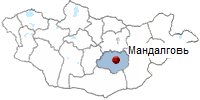Süm Khökh Burd. The ruined 10th-century temple Sum Khokh Burd. Baga gazariin chuluu rocky formation. Dundgov (Middle Gobi).
THE REGIONS OF MONGOLIA
DUNDGOVI AIMAG
The ruined 10th-century temple Sum Khokh Burd.


Dundgobi Aimag is the middle segment of the
Gobi-desert. Dundgobi Aimag has an area of 74,700 square kilometers and
population of 51.300 inhabitants. The administrative center is the town of
Mandalgobi at an altitude of 1,393 meters sea level in the vast open steppe,
260 kilometers from Ulaanbaatar. The territory of the aimag is the central part
of the Middle Khalhasain Plain, with an average altitude of 1.500 meters above
sea level, and the highest point is Delgerkhangai Mountain, which reaches 1,926 meters above sea level.
Baga gazariin chuluu rocky formation – located in Delgertsogt sum,
Dundgovi province and surrounded by plain. The highest rock one is 15 km long
and 10 km wide granite stone-mountain elevated at 1768m above sea level. There
are also over 20 kinds of medical herbs, many kinds of world rare animals like
marmot, ibex and mountain sheep. Also you can see Before Care, eye treatment
spa, rock images, petroglyphs, burial mounds and other sightseeing. There is a
ruin of Choir monastery which was established by “Zava” Damdin, a famous ancient
historical, religious and scientific researcher. This monastery had a monastery
with few monks translate, print, explain and advertise books from Tibetan
language and research religious philosophy and medical science.
Süm Khökh Burd. The ruined 10th-century temple Süm Khökh Burd sits on an
island in the middle of a seasonal lake, and was built from rocks that can only
be found more than 300km away. It was abandoned and left in ruins a few
centuries later and 300 years ago a palace was built in its place. When that too
fell into disrepair, the writer Danzan Ravjaa built a stage here. Makes sense.
The setting is that dramatic.
Behind it, enough of the temple and palace remain to give you some idea of their
previous magnificence. Even in ruins, with needle grass sprouting between the
stones, it's an impressive sight, thanks largely to its remote location. In the
evening when guests are on the premises, the ruins are lit up magnificently.
However, it's largely the domain of luxury tour groups and Buddhist scholars,
and outside of July the grounds may be locked (we hopped the fence, which is
easily done). During peak season, you may be lucky enough to stumble upon a
naadam performance staged on the concrete amphitheatre which fronts the ruins.
The lake itself, Sangiin Dalai Nuur, only encircles the palace after heavy
rains, but the perennial marsh provides good bird-watching. Various species of
eagle, goose and swan come to this spring-fed lake in summer and autumn.
The temple is located 72km northeast of Erdenedalai, 65km northwest of Mandalgov
and 21km west of Baga Gazryn Chuluu.
ADDITIONAL INFORMATION:
PAGES OF THE PICTURE ALBUM
|